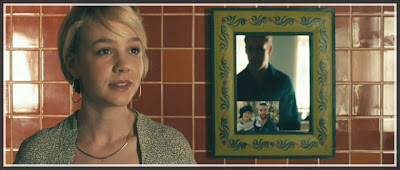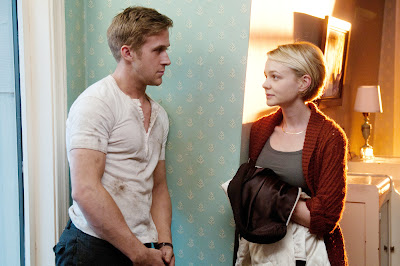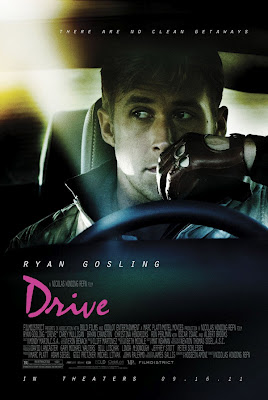This is a guest review by Leigh Kolb.
The 2011 film Drive opens by plunging the audience into an 80s-insipired neo-noir world, where the beats are hard, the car chases gripping, and the femme fatale seductively leads the real chase. Or at least it seems that simple.
The protagonist, simply named Driver (Ryan Gosling), may not appear to have clear motivations or desires throughout, but he is in control. He’s a stunt driver and auto mechanic by day, and an outlaw getaway driver at night. He seems to be content with this LA life he’s carved for himself.
Until he meets his neighbor, Irene (Carey Mulligan). The name Irene means peace—which could very well describe her disposition, but certainly not her role in Driver’s life. He first spots her carrying a laundry basket, then grocery shopping with her small son, and later helplessly looking under the hood of her stalled vehicle—the archetype of helpless femininity and quiet motherhood. She comes to the garage where he works for a repair and a ride home, and so begins their friendship/romance.
 |
| Carey Mulligan as “damsel in distress” Irene |
Driver takes on an immediate fatherly role to Irene’s son, Benicio, and the three have idyllic car rides and moments by a river. They are on a journey, but a journey that doesn’t really go anywhere. Irene, always in the passenger seat, places her hand on Driver’s on the gear shift. We see Driver smile at Irene, and Benecio seems protected and comfortable, especially in the scene that Driver carries a sleeping Benecio home while Irene follows, carrying Driver’s bright white satin jacket emblazoned with a gold scorpion.
Irene makes a passing comment that Benecio’s father is in prison.
She fails to mention he’s her husband. And he’s about to come home.
That white jacket doesn’t stay clean for long.
What comes next is a tour de force of quick, graphic violence. (Or, as the
New York Times rating more romantically describes it, “gruesomely violent chivalry”—he’s just valiantly protecting Irene, after all.)
The scorpion dances around its prey and its deadliness is swift and unsuspected. It also is a fiercely protective creature, and mothers keep their young nestled on their backs. Driver reminds a victim-to-be of the fable of the scorpion and the frog, in which the scorpion kills the frog (ultimately killing them both) simply because it’s his “nature.” The scorpion, upon first glance, reminds us of Driver. But who holds the “scorpion’s” fate—figuratively and literally—in her arms? Irene.
Of course, even as Driver is driving off with blood on his hands, no money, and no Irene, he calls her to tell her “Getting to be around you and Benicio was the best thing that ever happened to me.”
He has ensured their safety, while unraveling his own life. Unknowing, she stands silently, fingers to her lips.
A.O. Scott, in his
New York Times review, says “Ms. Mulligan’s whispery diction and kewpie-doll features have a similarly disarming effect. Irene seems like much too nice a person to be mixed up in such nasty business. Not that she’s really mixed up in it. Her innocence is axiomatic and part of the reason the driver goes to such messianic lengths to protect her.”
In
Rolling Stone, Peter Travers says, “Mulligan is glorious, inhabiting a role that is barely there and making it resonant and whole.”
The audience knows nothing about Irene, except that she met her husband when she was 17, she’s a waitress, and she’s pretty. How are we supposed to assume she’s “too nice to be mixed up in such nasty business”? How are we supposed to cling to her innocence and need for protection? How is a character who serves as a catalyst for almost the entire plot “barely there”?
Instead, the femme fatale role is squarely placed on the shoulders of Blanche. Travers writes, “Violence drives Drive. A heist gone bad involving a femme fatale (an incendiary cameo from Mad Men’s Christina Hendricks) puts blood on the walls.” This isn’t untrue—there is a heist gone wrong and it does get bloody, fast. But Blanche is an accomplice, not a seductive force that lures Driver in.
The classic definition of femme fatale is “an irresistibly attractive woman, especially one who leads men into difficult, dangerous, or disastrous situations…” Scott and Travers would certainly contend that Irene is too pretty and innocent to fit that mold—but someone needed to fit that mold, so Blanche it is.
Instead, Irene’s character is flattened into oblivion, “barely there,” as the reviewer states. Even though we know so little about her and her motivations, we are given clues. While she has an air of subservience (working as a waitress, fetching glasses of water and dinner for her male visitors), she is clearly in control at the beginning of the narrative. She goes to Driver’s work, she touches his hand, she withholds pertinent information about her personal life.
 |
| Ryan Gosling as Driver and Mulligan’s Irene–she holds his jacket (a symbol of his character) against the red and blue backdrop |
Irene is also presented in a constant mural of red and blue—the bright, dark red of cherries and blood, lust and violence, and the Wedgewood blue of the Virgin Mary’s mantle, innocent and pure. The colors of her apartment and her shirts and dresses mirror this color scheme, challenging us to imagine her as a complex woman, one who could inhabit both worlds of innocence and experience.
In the garage scenes, we’re reminded of the fact that cars get designated feminine pronouns (because they are designed to be owned and shown off), and are tools to attract women. Driver’s car of choice, as Shannon (Bryan Cranston) says, is “plain Jane boring… There she is. Chevy Impala, most popular car in the state of California. No one will be looking at you.”
While Irene isn’t “plain Jane boring”—of course she’s quite beautiful—perhaps her nondescript nature and lack of flash is what kept audiences from noticing her important role.
In the animal kingdom, impalas are largely gender-segregated, except during mating seasons, when males will work so hard at competing for the females that they often get exhausted and will lose their territories; they are showy creatures, leaping and running from prey and for fun. The females isolate themselves with their calves. This speed and agility makes it clear why Chevy would use them as a namesake for a model of car, but we would be remiss at not drawing the similarities between the gender roles in the film.
At the end, no one has gained, only lost. Driver leaves with his bloody, dirt-stained jacket, and Irene silently puts down the phone. They are separate—her with her child and safety, and him with his masculinity and “chivalrous violence” having come out on top, but with no reward but the protection of someone he’d just met. His femme fatale, if we must label.
 |
| Christina Hendricks as “femme fatale” Blanche |
And in the testosterone-fueled action genre, we must label our women. Even when it’s clear we’re supposed to challenge the virgin/whore dichotomy, even slightly, we cannot be trusted to. Irene and Blanche cannot be full, round characters—they must be caricatures to audiences and reviewers alike.
Much like the color imagery—from the aforementioned blues and reds to the hot pink Mistral font used on posters and in the opening credits—we can listen to the soundtrack to hear women setting the beat for the film, as stereotypically masculine as so many of the themes are. The opening sequence is set to Kavinsky’s
“Nightcall,” an intense electro house track, which starts with a gravely male voice and soon switches over to a melodic female singer. The bulk of the singing on the sountrack is by women, and this should remind us that the women are tuning the strings that will make the music of the plot.
Over the climactic shooting at the pizza parlor, the haunting voice of Katyna Ranieri sings Riz Ortolani’s
“Oh My Love.” Her voice soars, loudly and clearly over the bloody scene: “But this light / Is not for those men / Still lost in / An old black shadow / Won’t you help me to believe / That they will see / A day / A brighter day / When all the shadows / Will fade away.” She pleads for our protagonist, and she pleads for us, to look beyond the flat facades of what we expect, and to instead find the complexity of characters we think we know.
For the “kewpie-doll” can be the femme fatale, and the femme fatale can simply be an accomplice. Or perhaps the shadows of those labels can be lifted entirely, and we can be left with multidimensional female characters who are recognized for who they are.
———-
Leigh Kolb is an English and journalism instructor at a community college in rural Missouri, and has an MFA in creative nonfiction writing. She lives on a small farm with her husband, dogs, chickens, and garden, and makes a terrible dinner party guest because all she wants to talk about is feminism and reproductive rights.




